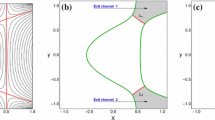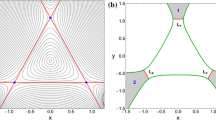Abstract
In this work, we try to shed some light to the nature of orbits in a three-dimensional (3D) potential of a perturbed harmonic oscillator with eight possible channels of escape, which was chosen as an interesting example of open 3D Hamiltonian systems. In particular, we conduct a thorough numerical investigation distinguishing between regular and chaotic orbits as well as between trapped and escaping orbits, considering unbounded motion for several values of the energy. In an attempt to discriminate safely and with certainty between ordered and chaotic motion, we use the Smaller ALingment Index (SALI) detector, computed by integrating numerically the basic equations of motion as well as the variational equations. Of particular interest is to locate the basins of escape toward the different escape channels and connect them with the corresponding escape periods of the orbits. We split our study into three different cases depending on the initial value of the \(z\) coordinate which was used for launching the test particles. We found that when the orbits are started very close to the primary \((x,y)\) plane the respective grids exhibit a high degree of fractalization, while on the other hand for orbits with relatively high values of \(z_0\) several well-formed basins of escape emerge thus reducing significantly the fractalization of the grids. It was also observed that for values of energy very close to the escape energy the escape times of orbits are large, while for energy levels much higher than the escape energy the vast majority of orbits escape extremely fast or even immediately to infinity. We hope our outcomes to be useful for a further understanding of the escape process in open 3D Hamiltonian systems.






























Similar content being viewed by others
Notes
Generally, any dynamical method requires a sufficient time interval of numerical integration in order to distinguish safely between ordered and chaotic motion. Therefore, if the escape rate of orbits is very low or even worse if the orbits escape directly from the system then, any chaos indicator (the SALI in our case) will fail to work properly due to insufficient integration time. Nevertheless, we decided to apply the SALI method regardless of the escape rate of orbits.
The term “escape positions” refers to the \((x,y,z)\) points of the 3D space at which the orbits intersect the cutoff surface with velocity pointing outwards and escape.
The stability of a periodic orbit is determined by computing the stability index (S.I.) [58]. A periodic orbit is stable if only the S.I. is between \(-2\) and \(+\)2.
References
Aguirre, J., Sanjuán, M.A.F.: Limit of small exits in open Hamiltonian systems. Phys. Rev. E 67, 056201-1–056201-7 (2003)
Aguirre, J., Vallejo, J.C., Sanjuán, M.A.F.: Wada basins and chaotic invariant sets in the Hénon–Heiles system. Phys. Rev. E 64, 066208-1–066208-11 (2001)
Aguirre, J., Vallejo, J.C., Sanjuán, M.A.F.: Wada basins and unpredictability in Hamiltonian and dissipative systems. Int. J. Mod. Phys. B 17, 4171–4175 (2003)
Arribas, M., Elipe, A., Floria, L., Riaguas, A.: Oscillators in resonance \(p{:}q{:}r\). Chaos Solitons Fractals 27, 1220–1228 (2006)
Barrio, R., Blesa, F., Serrano, S.: Fractal structures in the Hénon–Heiles Hamiltonian. Europhys. Lett. 82, 10003- 1–10003-6 (2008)
Barrio, R., Blesa, F., Serrano, S.: Bifurcations and safe regions in open Hamiltonians. New J. Phys. 11, 053004-1–053004-12 (2009)
Benet, L., Trautman, D., Seligman, T.: Chaotic scattering in the restricted three-body problem. I. The Copenhagen problem. Celest. Mech. Dyn. Astron. 66, 203–228 (1996)
Benet, L., Seligman, T., Trautman, D.: Chaotic scattering in the restricted three-body problem. II. Small mass parameters. Celest. Mech. Dyn. Astron. 71, 167–189 (1998)
Bleher, S., Grebogi, C., Ott, E., Brown, R.: Fractal boundaries for exit in Hamiltonian dynamics. Phys. Rev. A 38, 930–938 (1988)
Blesa, F., Seoane, J.M., Barrio, R., Sanjuán, M.A.F.: To escape or not to escape, that is the question—perturbing the Hénon–Heiles Hamiltonian. Int. J. Bifurcation Chaos 22, 1230010-1–1230010-9 (2012)
Caranicolas, N.D.: The 1:1 resonance in galactic type Hamiltonian systems. Astron. Astrophys. 267, 388–391 (1993)
Caranicolas, N.D., Barbanis, B.: Periodic orbits in nearly axisymmetric stellar systems. Astron. Astrophys. 114, 360–366 (1982)
Caranicolas, N.D., Karanis, G.I.: Chaos in barred galaxy models. Astrophys. Space Sci. 259, 45–56 (1998)
Caranicolas, N.D., Karanis, G.I.: Motion in a potential creating a weak bar structure. Astron. Astrophys. 342, 389–394 (1999)
Caranicolas, N.D., Zotos, E.E.: Investigating the nature of motion in 3D perturbed elliptic oscillators displaying exact periodic orbits. Nonlinear Dyn. 69, 1795–1805 (2012)
Churchill, R., Pecelli, G., Rod, D.: Isolated unstable periodic orbits. J. Differ. Equ. 17, 329–348 (1975)
Contopoulos, G.: Asymptotic curves and escapes in Hamiltonian systems. Astron. Astrophys. 231, 41–55 (1990)
Contopoulos, G.: Order and Chaos in Dynamical Astronomy. Springer, Berlin (2002)
Contopoulos, G., Efstathiou, K.: Escapes and recurrence in a simple Hamiltonian system. Celest. Mech. Dyn. Astron. 88, 163–183 (2004)
Contopoulos, G., Kaufmann, D.: Types of escapes in a simple Hamiltonian system. Astron. Astrophys. 253, 379–388 (1992)
Contopoulos, G., Kandrup, H.E., Kaufmann, D.: Fractal properties of escape from a two-dimensional potential. Phys. D 64, 310–323 (1993)
Contopoulos, G., Harsoula, M., Lukes-Gerakopoulos, G.: Periodic orbits and escapes in dynamical systems. Celest. Mech. Dyn. Astron. 113, 255–278 (2012)
de Moura, A.P.S., Letelier, P.S.: Fractal basins in Hénon–Heiles and other polynomial potentials. Phys. Lett. A 256, 362–368 (1999)
Deprit, A.: The Lissajous transformation. I. Basics. Celest. Mech. Dyn. Astron. 51, 202–225 (1991)
Deprit, A., Elipe, A.: The Lissajous transformation. II. Normalization. Celest. Mech. Dyn. Astron. 51, 227–250 (1991)
Eckhardt, B.: Irregular scattering. Phys. D 33, 89–98 (1988)
Elipe, A.: Complete reduction of oscillators in resonance \(p{:}q\). Phys. Rev. E 61, 6477–6484 (2000)
Elipe, A., Deprit, A.: Oscillators in resonance. Mech. Res. Commun. 26, 635–640 (1999)
Ernst, A., Just, A., Spurzem, R., Porth, O.: Escape from the vicinity of fractal basin boundaries of a star cluster. Mon. Notices R. Astron. Soc. 383, 897–906 (2008)
Ferrer, S., Lara, M., Palacián, J., Juan, J.S., Viartola, A., Yanguas, P.: The Hénon–Heiles problem in three dimensions. I. Periodic orbits near the origin. Int. J. Bifurcation Chaos 8, 1199–1213 (1998)
Ferrer, S., Lara, M., Palacián, J., Juan, J.S., Viartola, A., Yanguas, P.: The Hénon–Heiles problem in three dimensions. II. Relative equilibria and bifurcations in the reduced problem. Int. J. Bifurcation Chaos 8, 1215–1229 (1998)
Giorgilli, A., Galgani, L.: From integrals from an autonomous Hamiltonian system near an equilibrium point. Celest. Mech. 17, 267–280 (1978)
Hénon, M., Heiles, C.: The applicability of the third integral of motion: some numerical experiments. Astron. J. 69, 73–79 (1964)
Jung, C., Scholz, H.: Cantor set structures in the singularities of classical potential scattering. J. Phys. A 21, 3607–3617 (1988)
Kandrup, H.E., Siopis, C., Contopoulos, G., Dvorak, R.: Diffusion and scaling in escapes from two-degrees-of-freedom Hamiltonian systems. Chaos 9, 381–392 (1999)
Karanis, G.I., Vozikis, ChL: Fast detection of chaotic behavior in galactic potentials. Astron. Nachr. 329, 403–412 (2007)
Kennedy, J., Yorke, J.A.: Basins of Wada. Phys. D 51, 213–225 (1991)
Motter, A.E., Lai, Y.C.: Dissipative chaotic scattering. Phys. Rev. E 65, R015205-1–R015205-4 (2002)
Ott, E., Tél, T.: Chaotic scattering: an introduction. Chaos 3, 417–426 (1993)
Petit, J.-M., Hénon, M.: Satellite encounters. Icarus 66, 536–555 (1986)
Poon, L., Campos, J., Ott, E., Grebogi, C.: Wada basins boundaries in chaotic scattering. Int. J. Bifurcation Chaos 6, 251–266 (1996)
Press, H.P., Teukolsky, S.A., Vetterling, W.T., Flannery, B.P.: Numerical Recipes in FORTRAN 77, 2nd edn. Cambridge University Press, Cambridge (1992)
Saito, N., Ichimura, A.. In: Casati, G., Ford, J. (eds.) Stochastic Behavior in Classical and Quantum Hamiltonian Systems. Lecture Notes in Physics, vol. 93. Springer, Berlin (1979)
Seoane, J.M.: Effects of weak perturbations in open Hamiltonian systems. PhD thesis, Universidad Rey Juan Carlos, Spain (2007)
Seoane, J.M., Aguirre, J., Sanjuán, M.A.F., Lai, Y.C.: Basin topology in dissipative chaotic scattering. Chaos 16, 023101-1–023101-8 (2006)
Seoane, J.M., Sanjuán, M.A.F., Lai, Y.C.: Fractal dimension in dissipative chaotic scattering. Phys. Rev. E 76, 016208-1–016208-6 (2007)
Seoane, J.M., Sanjuán, M.A.F.: Exponential decay and scaling laws in noisy chaotic scattering. Phys. Lett. A 372, 110–116 (2008)
Seoane, J.M., Huang, L., Sanjuán, M.A.F., Lai, Y.C.: Effects of noise on chaotic scattering. Phys. Rev. E 79, 047202-1–047202-4 (2009)
Seoane, J.M., Sanjuán, M.A.F.: Escaping dynamics in the presence of dissipation and noisy in scattering systems. Int. J. Bifurcation Chaos 9, 2783–2793 (2010)
Siopis, C.V., Contopoulos, G., Kandrup, H.E.: Escape probabilities in a Hamiltonian with two channels of escape. N. Y. Acad. Sci. Ann. 751, 205–212 (1995)
Siopis, C.V., Kandrup, H.E., Contopoulos, G., Dvorak, R.: Universal properties of escape. N. Y. Acad. Sci. Ann. 773, 221–230 (1995)
Siopis, C.V., Kandrup, H.E., Contopoulos, G., Dvorak, R.: Universal properties of escape in dynamical systems. Celest. Mech. Dyn. Astron. 65, 57–681 (1996)
Skokos, C.: Alignment indices: a new, simple method for determining the ordered or chaotic nature of orbits. J. Phys. A Math. Gen. 34, 10029–10043 (2001)
Skokos, Ch., Antonopoulos, Ch., Bountis, T.C., Vrahatis, M.N.: Detecting order and chaos in Hamiltonian systems by the SALI method. J. Phys. A Math. Gen. 37, 6269–6284 (2004)
Zotos, E.E.: Application of new dynamical spectra of orbits in Hamiltonian systems. Nonlinear Dyn. 69, 2041–2063 (2012)
Zotos, E.E.: Trapped and escaping orbits in axially symmetric galactic-type potential. PASA 29, 161–173 (2012)
Zotos, E.E.: The Fast Norm Vector Indicator (FNVI) method: a new dynamical parameter for detecting order and chaos in Hamiltonian systems. Nonlinear Dyn. 70, 951–978 (2012)
Zotos, E.E.: Revealing the evolution, the stability and the escapes of families of resonant periodic orbits in Hamiltonian systems. Nonlinear Dyn. 73, 931–962 (2013)
Zotos, E.E., Caranicolas, N.D.: Are semi-numerical methods an effective tool for locating periodic orbits in 3D potentials? Nonlinear Dyn. 70, 279–287 (2012)
Zotos, E.E., Caranicolas, N.D.: Order and chaos in a new 3D dynamical model describing motion in non-axially symmetric galaxies. Nonlinear Dyn. 74, 1203–1221 (2013)
Acknowledgments
The author would like to thank the two anonymous referees for the careful reading of the manuscript and for all the apt suggestions and comments which allowed us to improve both the quality and the clarity of the paper.
Author information
Authors and Affiliations
Corresponding author
Rights and permissions
About this article
Cite this article
Zotos, E.E. A Hamiltonian system of three degrees of freedom with eight channels of escape: The Great Escape. Nonlinear Dyn 76, 1301–1326 (2014). https://doi.org/10.1007/s11071-013-1211-2
Received:
Accepted:
Published:
Issue Date:
DOI: https://doi.org/10.1007/s11071-013-1211-2




